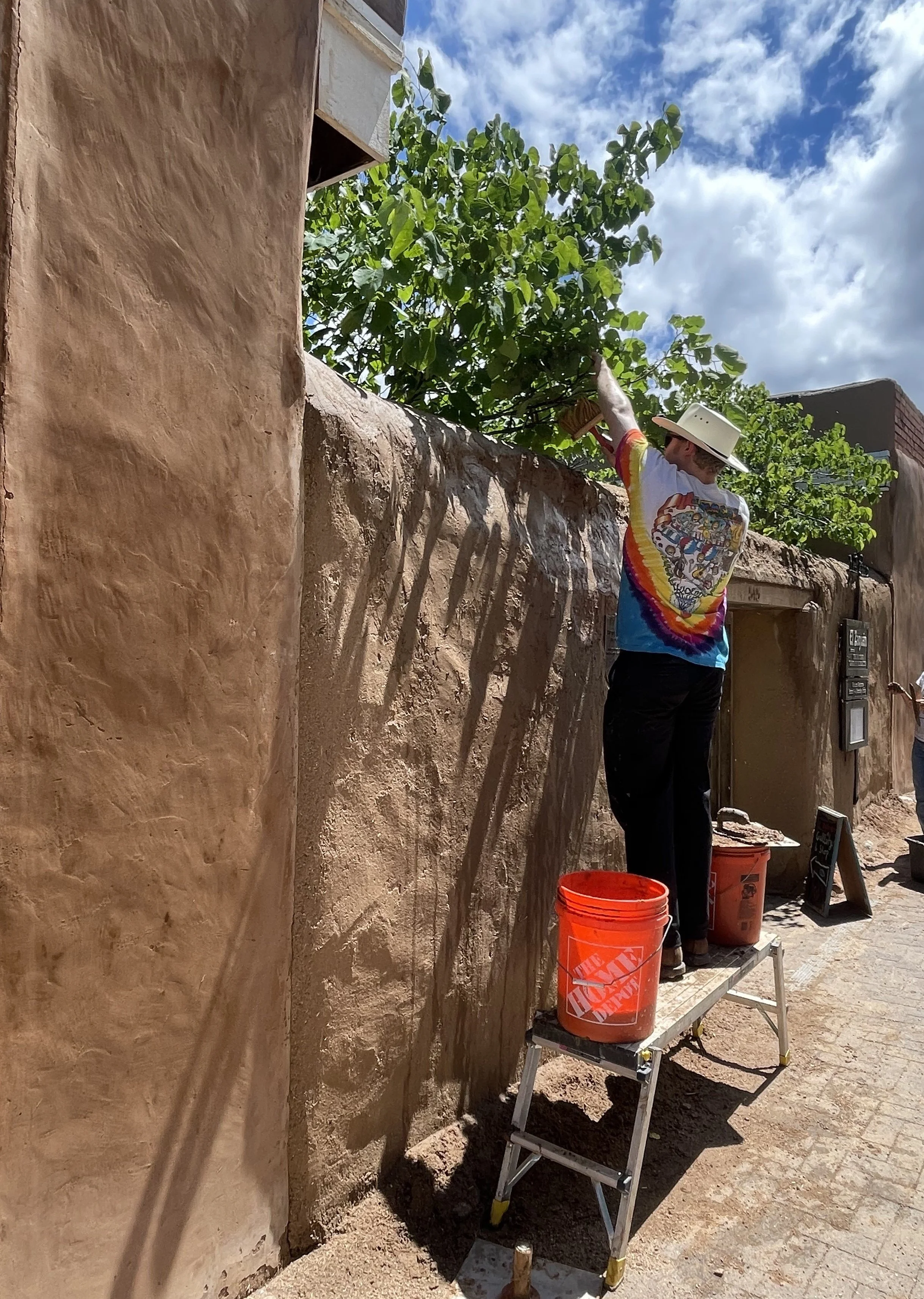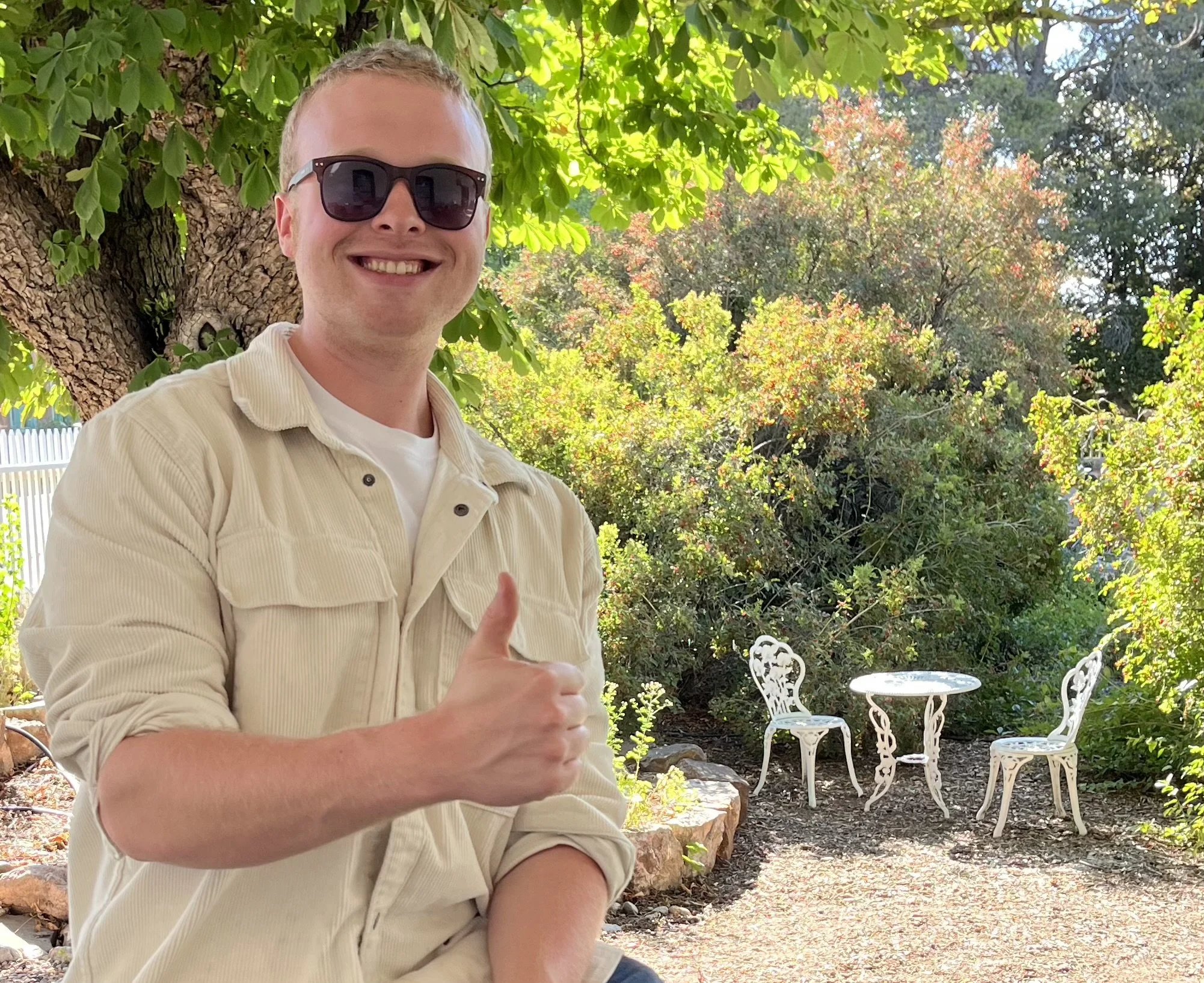Reflections from the Archive Room
By Miles Barth, St. John’s Professional Pathways Intern 2025
Miles Barth, St. John’s Professional Pathways Intern 2025 mudding the front wall of El Zaguán.
I spent a couple days of my two-month internship with the HSFF mud plastering the adobe entranceway of El Zaguán. This sort of plastering takes place every year. Rain, snow, and passing hands naturally wear away one summer’s work until, by the next, adobe bricks are intermittently revealed in gaps between the mud. Without the regular reapplication of a layer of mud plaster, the wall will crumble away.
The restoration process consists of mixing straw, clay, silt, and water in a wheelbarrow until the desired consistency of the mud is achieved. The mud is transferred to a bucket and applied by hand or trowel at first to the patchy parts of the wall, and later over the whole, in order to create a protective layer. The process of application would be described by some as meditative, as in the vein of gardening or working on a puzzle, or, by those who are less patient, as tedious. Without doubt, plastering offers ample opportunity for quiet reflection. While I worked through the cool part of the morning, I found my mind drawn towards my regular work during this summer at HSFS’s El Zaguán — archiving and filing the Foundation’s internal documents.
Now, do not let the words archiving and filing scare you off! I will not describe our old tax files or list the maintenance work done in the 1970s — I would never subject you to that! I led our attention, as mine was led while working on the wall, towards the HSFF archives for two reasons. First, I would like to share with you some gems from the pages of the archives, some amusing happenings in the history of El Zaguán. Secondly, I would like to circle back and make a point connected to mud plastering the archway (but there is no hurry with that and I hope to come to it quite naturally.)
The property manager for many years was Margretta Dietrich’s close friend Sylvia Loomis. Ms. Loomis saw many seasons of life at El Zaguán and recorded them in yearly reports from 1963 -1981, a tradition which executive director Elaine Bergman continued in 2007.
I enjoyed reading Sylvia Loomis’ reports greatly. Her personality comes through every page. Reading her reports sort of feels like talking to a passive-aggressive aunt; there is an ostensive objectivity which brims with emotion and judgement. For example, in 1976 she describes a maintenance man she hired this way: “He is a very pleasant, quiet young man and works well when he works, but his sense of responsibility to the well-being and tidiness of El Zaguán is apparently the least of his priorities, thereby requiring constant supervision on my part. He also believes that he is vastly underpaid for the work he does, and has requested that I place the matter of a raise in his pay to members of the Board of Directors at this meeting. I in turn request that a Special Committee be set up to consider this entire arrangement.” Ha!
Ms. Loomis consistently dealt with unruly tenants during her time at El Zaguan. In just one instance in 1975, #2-B was, “supposedly rented as an office for the Theater Arts Commission,” but, in fact, “turned into a rendezvous for midnight parties.” — She had to involve a lawyer to get those tenants to leave.
Sometimes her work required her to take physical action. In one incident around Christmas, El Zaguán’s wreaths were stolen: “...one of my tenants said she had just seen two drunks staggering up Canyon Road with what appeared to be one of our wreaths, so I dashed out the back door and caught them trying to sell for $20.00 the wreath at The Haven Restaurant about a block up the road. I yanked it out of their hands and returned in triumph…next year I may need to make changes in our Christmas decor.” This scene would be mirrored decades later in 2007, when executive director Elaine Bergaman scared someone off stealing money from the foundation, rushing and yelling at them. At the time Ms. Bergman wrote, “I grew up in a small town and believe in small town justice.”
These stories are a small fraction of the tales told in the archive. What all these stories, told over more than a hundred years, have in common is the devotion of so many towards the preservation of El Zaguan. Generation of different people - Margretta Dietrich, Dorothy Stewart, and Kate Chapman at one time; John Gaw Meem, Sylvia Loomis, and the whole early HSFF/El Zaguan Inc board at another, devoted themselves to the Sisyphean and at times grueling task of maintaining the building.
The task is Sisyphean because it cannot possibly ever be finished. The nature of preservation is to fight against time — attempting to pause the natural degradation and destruction that all things here are subject to. The enemy of preservation is time, and the only sorts of victories one wins against time are stopgap. Without yearly plastering, the entrance to El Zaguán would have disappeared decades ago. Without the work of generations of people, not only would El Zaguán have altogether disappeared, but many if not every historic building across Santa Fe would be gone. From reading through decades of records and correspondence that come from the conservation of just one building, it's become clear to me that preservation requires an active decision from every generation, and quite often in every year, for the preserver to stand against the course of time that would otherwise wash their subject away.
Preservation, seen this way, is an act of devoted love. Preservation asserts that its object is valuable enough to be insulated from time; that whatever it protects ought to be willed into the present even despite the corrosion of history. If you haven’t had the chance to visit El Zaguan in a while, I would recommend it. When I look at the building now, I do not only see a beautiful territorial building or a lovely garden — I see the love of 150 years made physically manifest.
Anyway, I’ve enjoyed being an intern here at El Zaguán this summer. I would like to thank Melanie McWhorter, Jacob Sisneros, Anne Kelly, and Story Coleman for their kindness and hospitality to me this summer, as well as Giulia Caporuscio for the same alongside the great preservation and archiving methods. I feel I have been treated quite humanely this summer; I would recommend this internship to anybody interested in historic preservation.
Miles Barth, St. John’s Professional Pathways Intern 2025


